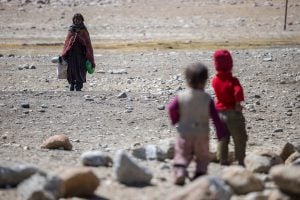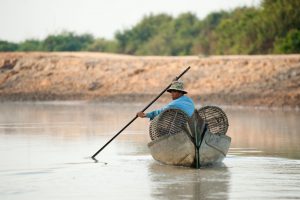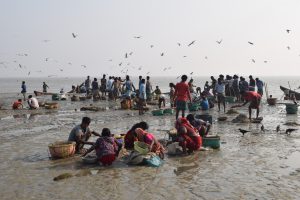As the Indian government announced its lockdown to be extended until May 3, 2020, the number of those infected by the Covid-19 novel Coronavirus keeps rising. As authorities work around the clock to “flatten the curve” and prevent community spread of the virus, public health messaging continues to stress the importance of hand hygiene and washing your hands frequently. But India’s water crisis is proving to be a major challenge in India’s efforts to combat the coronavirus.
Despite significant efforts to improve access to water supply and sanitation, nearly 163 million people in India lack access to clean and safe water and over 140,000 children succumb to diarrhoea every year, according to WaterAid. Across the country it is estimated that annually 600 million people experience water shortages and nearly 200,000 die due to inadequate or unsafe access to water supplies. The cost to the Indian economy is substantial, with approximately 73 million working days lost due to water borne diseases each year, resulting in an economic burden of an estimated USD 600 million annually. With climate change-induced variations in temperature and precipitation, large parts of India now seasonally experience extreme droughts and floods, creating misery for millions and challenges for governments in managing and balancing demand and competition between different sectors.
Government campaigns fail to deliver
In 2019, as large parts of India faced a major drought, Prime Minister Narendra Modi announced the creation of a new integrated water ministry – Jal Shakti – merging the former ministries of Water Resources, River Development and Ganga Rejuvenation, and Drinking Water and Sanitation. The government also announced a series of national initiatives to raise public awareness about water conservation, including the Jal Shakti Abhiyan (to promote water conservation in 256 of India’s most water stressed districts), Jal Jeevan Mission (to provide piped water connections to 146 million rural households by 2024), and Atal Bhujal (Groundwater) Yojana (to improve groundwater management through community participation in seven Indian states).
These measures are an effort to reform India’s water management institutions and practices that for decades have been characterised by an overwhelming focus on supply side infrastructure-intensive approaches; inefficient and wasteful water practices; siloed and fragmented institutional structures and mandates; limited implementation capacity; poor data management practices and inter-sectoral conflicts that have resulted in governance and accountability failures.
The 2012 National Water Policy did highlight the importance of an integrated approach but did not have a detailed enough roadmap on how India could get there. In 2016, an expert committee headed by former Planning Commission Member Mihir Shah did prepare an institutional roadmap. But its main recommendation to merge the Central Water Commission and the Central Ground Water Board has not been implemented.
Political drivers of India’s water crisis
Alongside institutional and administrative reforms, policymakers must also come to grips with the complex political economy of water. Since Independence, sucessive governments have prioritised providing food security and expanding agricultural food production. Expanding India’s canal and irrigation infrastructure was key to the Green Revolution and to India’s ambition of achieving food security. However, it came at the cost of a deeply entrenched, politically expedient and publicly accepted perception that water is a public good that should be freely and limitlessly available.
Across large parts of India, a long history of state provision of free electricity (for pumping) and access to water to farmers has resulted in inefficient and wasteful irrigation practices. As a result, water intensive crops (rice, wheat, sugarcane, oranges, etc.) are being grown in agro-climatic zones ill-suited to them. Unregulated and free access to groundwater has resulted in unlimited rural, urban and industrial extraction. The impacts are evident in the widespread water shortages in rural and urban areas including large metropolitan centres such as Delhi, Chennai, Bengaluru and Mumbai.
Fear of backlash
While policymakers recognise that rationalising the usage and pricing of water is necessary to curb wasteful practices, it remains politically contentious. Successive governments have been reluctant to change the status quo for fear of political backlash and loss of votes from farmer lobbies and groups.
Efforts to privatise India’s drinking and domestic water supply have been equally contentious, with legitimate civil society concerns raised over quality and equitable access given high levels of income inequality. While some states such as Punjab are experimenting with schemes designed to incentivise farmers to use less water and electricity, and Maharashtra is trying bulk water tariffs for industries using water as a raw material, water management continues to be deeply political in India.
Acess to water – still an “aspirational” goal
Providing access to piped drinking water is one of India’s ruling Bharatiya Janata Party’s key electoral commitments with significant funds being allocated in the central budget for this. Echoes of the potential political mileage that can be gained from such measures can be seen in the electoral commitments of smaller parties such as the Aam Admi Party (AAP). In the recent Delhi election, AAP campaigned on a number of development issues including an offer to provide residents with zero water charges (for usage of up to 667 litres per day). Though the AAP has been criticised for promoting wasteful practices, it underscores the continued appeal of subdised/free water even among urban voters. In the wake of AAP’s huge victory, other political parties such as the Congress have also promised free water in their state electoral campaigns.
Small steps forward
It is positive that the government continues to give high priority to water and is taking steps to move towards a more integrated and holistic approach to water management. In November 2019, the Jal Shakti ministry announced the setting up of a new 10 member committee which will be again headed by Mihir Shah to look into revising the 2012 National Water Policy. The committee’s mandate includes updating the policy and providing recommendations to reform existing governance structures and regulatory frameworks.
As we head into another scorching summer in the shadow of the Covid-19 crisis, the committee will have its work cut out. Key on its agenda will be honing the institutional and structural changes needed to improve governance and management of India’s water resources at federal, state and local levels. But equally critical will be finding creative solutions to guide the use, allocation and distribution of water while balancing competition between sectors – using principles of equity, inclusion, social justice and environmental sustainability.
The central budget for 2020-21 describes access to water as one of the key aspects of an “aspirational India” along with access to better health, education and jobs. It is tragic that more than 70 years after Independence access to water remains an “aspirational” goal for millions in India. But aspiration can become reality only when implementation of existing laws, policies and programmes is backed by the political will to bring about transformational change in the way water is used and valued.
![<p>Access to piped water in every home is a government pledge, but there is a long way to go before that becomes a reality [image: Alamy]</p>](https://dialogue.earth/content/uploads/2020/04/water-crisis-India-covid-19-scaled.jpg)







